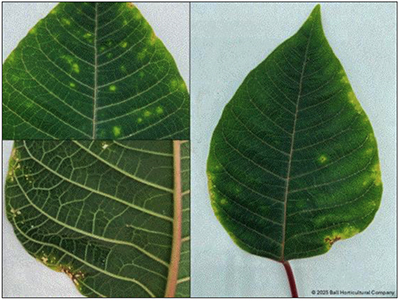This week, Nick Flax has been working with growers across North America on an issue that usually arises later in production but seems to be hitting early this year.
PROBLEM: This week started off with a flurry of emails and calls from growers reporting spots that suddenly appeared on their poinsettias. Lesions with tannish colored centers, yellow margins in some cases, and random distribution across symptomatic leaves, all of which seem like early symptoms of Alternaria, anthracnose (scab), or Xanthomonas infection.
NICK’S TIP: After looking at similar photos from several growers, it seemed pretty clear that there was some sort of pathogen outbreak brewing. That was until our plant pathologists examined multiple specimens submitted by different growers… No bacterial streaming from the spots, no signs of fungal mycelia or fruiting bodies were found—just (drumroll please) … crud!
Normally, I don’t put the word out about this oddly named disorder until mid to late November, but apparently crud came early this year. If you’ve seen similar symptoms in your poinsettia crop recently, take note to ensure your poinsettias don’t get cruddier.

What Is Crud?
“Crud” is a highly technical term for latex eruption that occurs when plant/water relations are out of whack. Excessive turgor pressure causes cell walls in leaves or bracts to burst, after which vascular fluid erupts out of the plant. This can occur when environmental and crop cultural factors combine to create excessive turgor, including when:
• growing media is overly wet going into the night,
• nighttime air temperatures are high,
• relative humidity is excessively high, and/or
• drastic weather changes spike or crash air temperature in the greenhouse.
Fertilizer salt accumulation in the growing media can also be a factor in the incidence and severity of latex eruption. As plants mature and overall growth begins to slow, roots will still take up excess fertilizer salts in the media. Additional salt uptake often forces roots to take up additional water to maintain osmotic balance, and this can further increase turgor.
Unfortunately, once latex eruption occurs, there is no way to undo the damage. Ruptured cells are completely compromised and will not recover, so this disorder can have a lasting impact on your crop’s aesthetic. The good news is that this time of year, you still have time to push growth and cover up damaged foliage.
Incidence and severity of “crud” will vary from one operation to the next, but some varieties are more prone to this disorder than others. Since moisture management and temperature are the primary drivers for this disorder, occurrences are typically more severe in hot spots throughout your greenhouses, near side vents, breezeways, doors, or areas with poorer air flow. As such, it’s best to focus on prevention:
• Allow moderate dry-down between waterings. On the 1–5 moisture scale (1 = air dry; 5 = saturated), avoid watering above a level 4 and only dry down to a level 2.
• Increase airflow and air exchanges (when possible) during the daytime to help drive transpiration and shorten dry-down time after you water or fertigate.
• Avoid late afternoon or evening irrigations unless plants are dangerously dry and at risk of wilting.
Sooty mold and other opportunistic organisms may start to grow on the nutrient-rich vascular fluid if it accumulates on the leaf surface, but they won’t ultimately hurt the plants. However, if moderate to severe damage occurs due to latex eruption, compromised tissue can provide an entry point for pathogens like Botrytis. It’s best to apply a broad-spectrum foliar fungicide out of an abundance of caution.